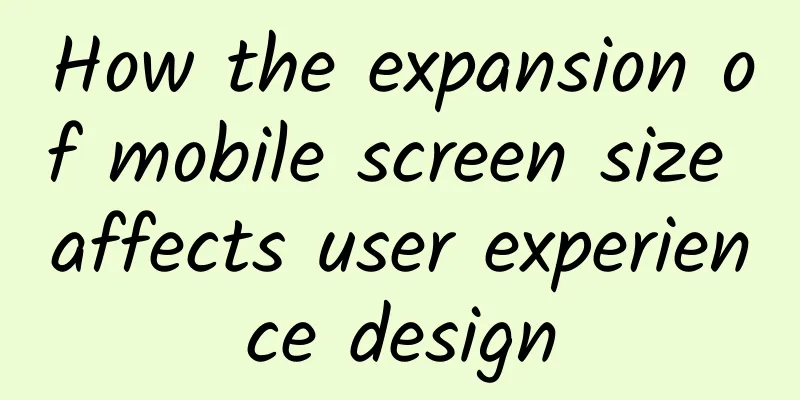How the expansion of mobile screen size affects user experience design

|
The era of small-screen phones with various shapes is gone. In fact, the industry trend in recent years shows that large-screen phones, or giant-screen phones, will dominate the mainstream for a long time. Now, it is time to summarize the failures of designers in the past few years when it comes to large-screen phones. How to define a large-screen mobile phone? In fact, simply calling it a big screen is not particularly accurate. Its English name is more vivid: Phone+Tablet=Phablet. In other words, it is a combination of a traditional mobile phone and a tablet, a Phablet. Therefore, these large-screen phones are actually larger than what we are used to and can handle, but they are not as big as tablets. To be more precise, they are large-screen phones with screen sizes ranging from 5 to 6.9 inches. For reference, the screen size of iPhone 4 & 4S is 3.5 inches, iPhone 5 & 5S is 4 inches, iPhone 6 is 4.7 inches, and iPhone 6P is 5.5 inches. So, you can quickly determine the type of phone just by looking at the screen size. Although phablets are not new now, most users first knew about them from Samsung's Note series, and only started to pay attention to them after the iPhone 6P became popular. The earliest phablet can be counted as Samsung's Galaxy Note, which was released as early as 2011. Tracing the roots In the era of feature phones, where mobile phone calls were the main form of communication and text messages were the secondary form of communication, most users would hardly purchase content through their mobile phones. However, it is completely different now. It is no longer a new thing for users to purchase digital content on their mobile phones, and the consumption of digital content will increase. This is inseparable from the growth of mobile phone screens and changes in the way of interaction. According to research and analysis by Statista, the mobile phone market will grow at a rate of 4% per year from now on, and by 2018, the growth rate of large-screen mobile phones is expected to be as high as 36%. Without thinking too much, I think you can understand how much room for imagination there is. Large-screen phones are naturally stylish and cool. Nowadays, many users abandon their previous small-screen smartphones and join the camp of 5-inch large-screen phones. However, they are not sure whether a larger screen can bring them a better and more comfortable user experience, after all, the size of the palm has not increased. Therefore, the interaction between users and large-screen phones needs to be adjusted. You may have come across a thumb heatmap of a phone screen, which shows how people hold their phones and identifies areas that are easy to reach with the thumb and areas that are hard to reach with the thumb.
In fact, the thumb operation heat map was first used by designer Steven Hoober in his 2011 book "Designing Mobile Interface". He called the green part "the area that the thumb touches the most when holding the phone with one hand". The measurement of these areas was summarized through 1,333 observations and analyses. These analysis data also show that 49% of users are accustomed to holding the phone with one hand, using the thumb to control the screen, and using the other hand to do other things. Based on these reports of the year, the following information was also obtained:
But after the era of "3.5-inch mobile phones" has passed, what is the control situation on large-screen mobile phones? Do users need to stretch their thumbs to click the buttons on the other edge of the screen, or do their grip methods change? Steven Hoober's research data shows that "the proportion of users holding with one hand has decreased, and they will use the other hand more, and will frequently switch between two hands for input or grip." This situation has extended to devices of different sizes, including ordinary mobile phones, large-screen mobile phones and tablets. Take a look at the operation heat map of the user's thumb when holding with one hand. The green part is the comfort zone, the orange part is the area that can be reached by stretching the finger, and the red part is the area that the thumb cannot reach. Obviously, the thumb control area is not large on these large-screen mobile phones, and users will not use their thumbs to complete complex tasks and "take on" all operations with one hand. Therefore, this is why users will adjust their grip, adapt to the new grip strength, try to adapt to the new control and interaction methods, and interact easily with large-screen mobile phones. This seems to be a relief. Considering the size of large-screen mobile phones and the complex interaction of the interface, users still use one hand to hold the phone in most cases (the holding method has changed). In this way, in order to take into account both holding and interaction, the user's largest operating area on large-screen mobile phones is still very close to the previous thumb comfort zone. Unfortunately, this is not the case. How to design interface/interaction/user experience for large-screen mobile phones As a pioneer in the field of large-screen mobile phones, the Samsung Galaxy Note series has made great contributions to the market and users, but when it comes to interface, interaction and user experience, its only contribution may be the stylus. Another embarrassing reality is that the vast majority of Note users have hardly ever used their stylus. Correspondingly, Apple seems to be more concerned about large-screen optimization. The release of iPhone 6P exposed all the problems, and iOS designers added many "accessibility" designs. For example, after double-clicking the Home button, the content at the top of the screen will be pushed down to the comfort zone to facilitate user operation. Many of these designs are typical compromises, with improvements in design but not good enough. In addition to the iPhone, there are all kinds of Android phones, which are basically different in nature, and the quality of UI and interaction design is even harder to say. Luke Wroblewski also provided another solution: move the most important interaction points to the bottom of the screen and arrange them from bottom to top according to the importance of these buttons/controls/operation areas. (The domestic mobile phone manufacturer Meizu launched the Smartbar solution when designing Flyme, which is basically consistent with this idea) For iOS, it is naturally good to follow this solution for design, and the same is true for Android, but Apple and Google can only control the design on the system, and specific APP developers and designers need to make more in-depth considerations on this.
***'s thoughts The popularity of large-screen mobile phones is still growing rapidly. Larger screens and richer digital content are reshaping our era, and mobile design is quietly changing everything. In the UI, interaction and user experience design of large-screen mobile phones, we still need to understand more actual conditions, collect more data support, and have more considerations in UI/UX decision-making. In all mobile phone and mobile phone system launch conferences in the past two years, every speaker has emphasized that "we have special skills in optimizing the interface of large-screen phones", but in actual use, the strange and bizarre operation methods still make people feel unnatural. In the future, there is still a long way to go, and there is still a lot of room for improvement. 【User Experience Design Practice】 Understand the rules and lay the foundation: "Super useful! 10 practical rules for web design beginners" Find the right angle to strike: "Win with details! How to improve user experience in four aspects?" Understanding how users find bugs: Negative Energy Sniffer! Details on the website that drive users crazy |
<<: Nintendo will develop iOS games itself: no porting, no remakes, or free in-app purchases
>>: Testin crash analysis: one line of code allows you to easily find bugs
Recommend
How to tame a giant pterosaur that is bigger than the US F-16 Fighting Falcon?
Pterosaurs are probably the closest to dragons (d...
How can a promotion account achieve the best delivery effect? Here are 8 tips
Have you ever encountered this situation? You too...
Apple iOS 15.5 is officially released. Learn what’s new in this article
After several weeks of testing, Apple has finally...
Typhoon Haikui makes landfall for the third time! Why are autumn typhoons so powerful? How to deal with them scientifically?
Monitoring by the Central Meteorological Observat...
The number of infected people has exceeded 1,000! The latest report from this place
The latest data released by the Anhui Provincial ...
Analysis of Keep’s model centered on user growth!
The author of this article conducts a detailed an...
It can actually be done this way - a new way for programmers to increase their salaries
[[153201]] My friend Mr. A is a typical .NET deve...
About domestic programmers climbing over the firewall
[[226521]] I originally had no inclination to dis...
When Joyoung meets intelligence, the healthy kitchen of the future will come sooner
Smart homes allow us to see and feel more and mor...
Do you think the official version of iOS 10.2 improves iPhone battery life?
iOS 10.2 is Apple’s latest iOS operating system. ...
Should I be overly concerned about my iPhone's battery health? Not necessarily.
In the early days when Nokia was popular or when ...
How to move forward on the road to subverting the education industry under the comprehensive impact of STEAM and Makeblock?
In May this year, at the Google IO 2016 Developer...
Review of marketing planning cases and the cool advertising in 2019!
• Introduction• "It's fun to be silly fo...
Online education: 3 high-growth traffic conversion models
The article summarizes the common conversion mode...
Nine content marketing tips to help you create killer copywriting!
The prevalence of self-media has made us realize ...









